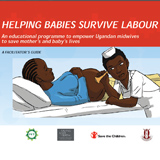
Introduction to this learner’s guide
Why this guide?
There are almost 1.2 million intrapartum stillbirths and 1 million neonatal deaths due to birth complications worldwide each year. Uganda, with an estimated 38.000 stillbirths and 46.000 neonatal deaths each year, is in the top 20 countries with the highest perinatal mortality . These are shocking numbers that need to be reduced. Most fresh stillbirths and many early neonatal deaths are caused by too little oxygen during labour. These babies have usually grown well and thrived during pregnancy, only to die or suffer serious brain damage during the few hours of labour. The aim of fetal monitoring during labour is to identify babies who develop complications in labour due to too little oxygen, so that labour and delivery can be actively managed in order to deliver a healthy baby.
Who is this for?
This learning guide is for doctors, midwives and student doctors and student midwives working in Ugandan hospitals and clinics. This learning guide may be used as a self learning program or can be used as part of an in-service course. A facilitator’s guide for this training guide is also available.
What does it teach?
The goal of this training guide is to improve the outcomes for babies and mothers. The ma- terial will cover why a baby needs to be monitored during labour. It will tell how to monitor a baby, how to interpret your observations and recordings and most importantly, it will give guidelines on what to do when something is wrong.
This learning guide does not cover other pregnancy and birth related complications like pregnancy related illnesses, abnormal progress in labour, post partum hemor- rhage and neonatal resuscitation.
How can it be used?
This learning guide can be studied individually, or as part of a long-distance study module. But to make the course more effective, it is preferred to let a trained person facilitate the material. This can be done as a one day course or over 4 different sessions by using the different modules. The material may also be added to an existing course or used as a reference book during work.